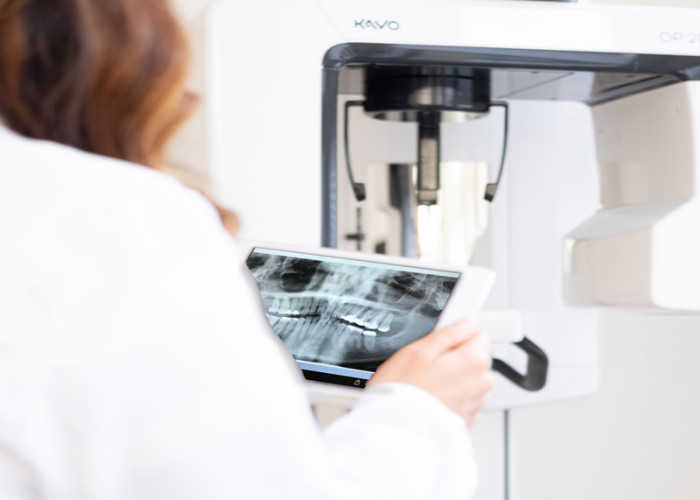What can be responsible for jaw pain
Jaw issues like cracking, tension, and pain can result from misalignment. Mild to moderate malocclusion can be corrected painlessly.

Tense jaw
There are various causes of a tense jaw. The jaw can tighten due to psychological strain, such as stress. Often this happens subconsciously at night during sleep. Other causes of jaw tension can be malocclusions of the bite.
Jaw tension leads to pain, which is why sufferers are often advised to use a relaxation splint or a grinding splint.
But there are also special relaxation exercises that only take a few minutes and are very simple to loosen the jaw.
For example, an effective exercise is to place the fingers in front of the ears while opening the mouth. This involves massaging the areas with light pressure for two minutes. With regular practice, you will notice how your jaw relaxes.
Another form of pain relief is warming or cooling the jaw. An infrared lamp is often used for this purpose. You can repeat this process up to three times a day.
Dislocated jaw
With a dislocated jaw, the lower jaw imprints to the right, left or forward and the mouth cannot be closed.
Affected people experience severe pain especially when moving and opening the jaw, as well as when chewing.
A dentist or doctor can set the jaw again by applying pressure and moving the jaw into the intended position.
If the jaw cracks or hurts when eating or chewing, it is usually not a dislocated jaw. Approximately one third of the population repeatedly experience cracking or squeaking noises. Massaging the cheek muscles and temples regularly helps many affected persons.
To make sure that the jaw cracking is harmless, you should have your teeth and jaw checked by a dentist.
Jaw grinding
If the jaw grinds when opening the mouth, yawning or chewing, this is often an alarm signal and indicates a misalignment of the jaw. To avoid consequences such as tense jaw muscles combined with shoulder, neck, head or ear pain, you should see a dentist.
Recognise and treat jaw misalignments
Jaw misalignment can be recognised by the fact that chewing becomes difficult and painful. In addition, it can lead to pain and tension in the jaw, shoulder or neck area. Headaches or earaches are also not uncommon.
Jaw misalignments are mostly hereditary, but can also develop due to external influences, such as thumb sucking in childhood or diseases.
Jaw misalignment can be detected by large gaps or overlapping teeth. The various jaw malocclusions include crossbite, open bite, overbite, fore or even frontbite or deep bite, but also rotated or crooked teeth.

Dental reconstruction and malocclusions
The human set of teeth of an adult consists of a total of 32 teeth: two incisors, one canine, two premolars and three molars. If there are large gaps between the teeth or the teeth do not meet correctly, this is called a malocclusion of the jaw. Such misalignments have both aesthetic and medical consequences. These include:
Crossbite
Open bite
Overbite
Overjet
Underbite/Deep Overbite
Crowding
Gaps
Twisted teeth
Crooked teeth
Treatment options
Such a misalignment can be corrected for aesthetic or medical reasons. For mild to moderate malocclusions, sufferers are advised to use a dental splint, fixed or loose retainers.
The advantage of invisible retainers is that they correct misalignments without the aligners being visible and at the same time have the same effect as fixed retainers.
Loose retainers are only recommended for very slight malocclusions.
LEARN MORECosts of jaw surgery
In the case of very severe jaw misalignments, only surgery can correct the painful misalignment. The costs and time required depend on the type and severity of the misalignment. As a rule, however, such complex operations are very lengthy, so that it can take several months until the final result is achieved.
If the operation is medically necessary, the health insurance company will cover the costs of the operation, as well as the costs of the accompanying orthodontic therapy.
Exercise the jaw to relieve pain
There are some exercises to relax the jaw, neck, shoulders and head. Nevertheless, these do not combat the cause of the problem, but only alleviate the pain.
To loosen the jaw muscles you can massage your jaw on both sides with your fingers in circular movements. Open your mouth for about ten seconds. This stretches and relaxes your jaw at the same time.
There are also some simple exercises to strengthen the jaw muscles. For example, you can press your left hand against your left cheek and at the same time push your chin against your palm. It is most efficient if you repeat the exercise on both cheeks about five times, three times a day.
Wisdom tooth surgery
After wisdom tooth surgery, both the exposed nerve endings and swelling that occur after such surgery can cause pain. There may be a feeling of tension in the jaw area.

If bacteria penetrate the open wound, this can lead to an inflammation of the jaw. Symptoms that indicate this are redness in the face, swelling and throbbing in the jaw and increased temperature. In addition to this, lymph nodes may swell.
WISDOM TEETHLockjaw
Lockjaw manifests itself when you feel severe pain when eating or yawning and can no longer open your mouth fully.
To counteract this, you can train your jaw and strengthen the muscles.
Here it is helpful to make side to side movements or up and down movements with your jaw. Make sure that your teeth do not rub against each other. Then stretch your jaw by opening it as wide as possible and closing it again.
To prevent jaw cramps, you can take magnesium, calcium, and vitamin D.